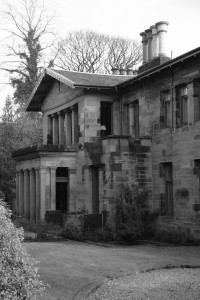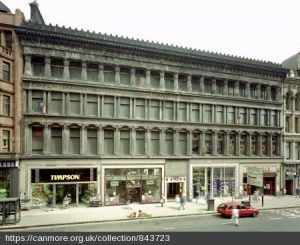To celebrate the bicentenary of Alexander ‘Greek’ Thomson‘s birth a programme of events and activities have been planned to take place throughout 2017. We will continue to update this calendar throughout the year with more and more exciting events as these are confirmed so please keep checking back. You can also sign up to our e-mail newsletter here to stay up to date.
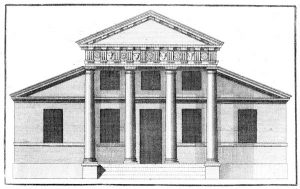
American architect and Renaissance architecture expert Gary Paul will discuss the work of Andrea Palladio, whilst also referring to the work of Frank Lloyd Wright and Alexander Thomson.
Andrea Palladio’s work has been valued as the quintessence of High Renaissance calm and harmony. His reputation is based on his skill as a designer of villas, located in what was the Venetian Republic in northeastern Italy. Palladio’s teachings, summarized in the architectural treatise, The Four Books of Architecture, gained him recognition around the world.
Gary Paul is a graduate of the schools of Architecture at the Boston Architectural Center (B Arch) and Harvard Graduate School of Design (M Arch). He has maintained a design practice in New York City for 30 years, working on homes, apartments and small commercial projects. Gary’s work has been featured in magazines such as House Beautiful, House & Garden and Veranda, Country Living and The Chicago Tribune/Homes, NY Women; and in articles in the Detroit Free Press, and The New York Observer, and The New York Times.
Gary has taught and served as Design Critic in Architecture and Interior Design Courses at New York University, City College, Harvard, Yale, the Univ. of Illinois (Chicago), the Roycemore School, Parsons School of Design, NY Institute of Technology and The Boston Architectural Center. A lifelong love of the work of Renaissance Architect Andrea Palladio has taken Gary on countless research trips across the north of Italy to study Palladio’s many villas and public buildings.
Gary has sought out the work of Palladio’s late Renaissance predecessors, such as Giulio Romano, Alberti, and Scamozzi, as well as the frescoed interiors by artists such as Veronese and Tiepolo, (father and son), in many of these buildings. He has also researched the political, cultural and religious forces which shaped the Veneto in the 16C giving greater context to this rich period of artistic endeavor.
In order to share his passion Gary has orchestrated and has led tours for clients, design industry professionals, and other architecture enthusiasts Gary’s tours traverse the backroads of the Veneto and up into the pre-Alps, from Mantua to Treviso, incorporating time for detours to view modern works such as those of the 20c architect Scarpa, to hidden treasures such as the Canova Museum, and, to magnificent walled towns such as Marostica and Sabbioneta and Asolo as well as, of course the Museum Palladio in Vicenza.
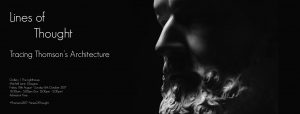
Lines of Thought is an exhibition about architectural drawing and representation and is devoted to the work of Alexander Thomson, one of Glasgow’s most renowned nineteenth century architects. Curated and organised by the Alexander Thomson Society it celebrates the bicentenary of Thomson’s birth in April 1817 through a selection of original drawings by the architect and those of others who have later recorded or interpreted his work in a range of media including pen and ink measured studies, detailed digital renderings, precision models, journals, publications, sketches, film and the more abstract work of artists. The intention is to reveal the industrious, creative as well as the more complex side of the architect, his prolific imagination and uniquely creative architectural contribution to the architecture of the city of Glasgow and the Clyde estuary.
The exhibition is timed to coincide with the 13th biennial International Conference of the European Architectural Envisioning Association with a 3 day conference titled Space Time & Meaning hosted by the Glasgow School of Art and organised by the Mackintosh School of Architecture and the School of Simulation and Visualization.
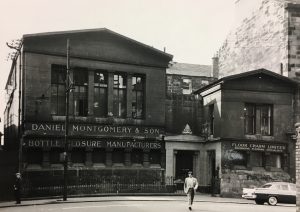
Lost Thomson: Glasgow’s Loss
Thursday 21 September, 6pm
£10 (£5 discounted rate for members of the Glasgow Art Club)
In his bicentenary year, Fiona Sinclair gives an insightful talk on the lost works of the eminent architect Alexander ‘Greek’ Thomson.
Please arrive at 6pm for a welcome drink, with the talk commencing at 6.30pm sharp.
Alexander Thomson was born in Balfron, Stirlingshire, on 9th April 1817 and died in Glasgow on 22nd March 1875 at his home at no.1 Moray Place in the terrace he had himself designed.
Thomson was extremely successful with a large clientele for medium-sized villas and terraces of cottages in Pollokshields, Shawlands, Crossmyloof, Cathcart, Langbank, Bothwell and Cove and Kilcreggan.
In his day, Thomson was conspicuous for his originality in producing a distinctive modern architecture from the lessons and precedents provided by the Greeks, Egyptians and other ancient civilisations, and made extensive use of new materials like cast-iron and plate-glass.
His personal Graeco-Egyptian style was almost entirely confined to Glasgow, where he designed commercial warehouses, blocks of tenements, terraces of houses, suburban villas and three extraordinary Presbyterian churches, of which the St. Vincent Street Church is the only intact survivor.
Other important works still standing include Moray Place, Great Western Terrace, Egyptian Halls in Union Street, Grecian Buildings in Sauchiehall Street, and his villa, Holmwood, at Cathcart, which is now owned by the National Trust for Scotland.
Whilst a wealth of Thomson buildings remain there are also a significant number that have been tragically lost over the years. The reasons for these losses are several, from Thomson demolishing his own buildings – as with the Scottish Exhibition Rooms on Bath Street, through to bombing during World War II – as with Queens Park Church. The most common reason for the loss of these buildings however was redevelopment during the 1960s and 70s.
The losses were primarily tenemental properties spread throughout the city, however also included were two hotels, a printing works, a sculpture yard and two churches; Chalmers Memorial Free Church in the Gorbals and Queen’s Park Church.
Following his death in 1875, a marble bust of the architect by John Mossman was presented to the Corporation (now in the Kelvingrove Art Gallery) and the Alexander Thomson Travelling Studentship established, of which the second winner was Charles Rennie Mackintosh.
A map of the ‘lost’ buildings can be viewed here
Fiona Sinclair, is a Glasgow based architect and author with a passion for historic buildings.
If you wish to find out more about becoming a member of The Glasgow Art Club please visit our website

